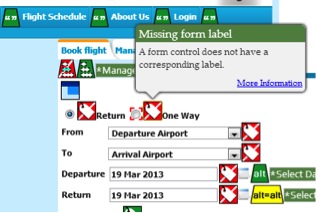The following is a contributor post from Chris Rourke, MD of User Vision.
“The power of the Web is in its universality. Access by everyone regardless of disability is an essential aspect.”
— Tim Berners-Lee, W3C Director and inventor of the World Wide Web
Well, that was the intention at least.
The reality is very different, especially for most sites representing companies and organisations in the Arab world. Every day thousands of people with disabilities are unable to take full advantage of the incredible information and services available on the web.
They find their online goals, whether for work or personal use, are difficult or impossible to perform.
Why? Because sites have not been developed with accessibility in mind and this problem is especially common in the Middle East. Web accessibility is typically not high on the agenda for businesses online or the digital agencies they commission and the result is frustration and failure for thousands of people with disabilities.
Web accessibility is about enabling people who may need to use your site slightly differently than you might expect. Some visitors might want to increase the text size with browser controls or navigate by tabbing rather than use a mouse. Others may use assistive technology to navigate through voice commands, magnify the screen or hear the site content through a screen reader. All of these will benefit from a site designed to allow these adaptations to be made so they can control their view and use of the site. Essentially the site needs to meet the user half way by being coded in a way that allows user adaptations or assistive technologies to be used to improve the experience.
Why does accessibility matter? First of all it’s the right thing to do – the web has been incredibly empowering to all of us, and the intention is that a person’s disability should not prevent them from enjoying the benefits. It also make good business sense, especially if you are in B2C or B2B commerce, it really does not make sense to exclude some of your target audience. Making your site accessible will help you avoid certain PR or legal risks and the fact that accessible sites display the best coding and mark-up means there is a strong correlation between good accessibility and search results. Google likes accessible sites and rewards them for that fact in their search algorithm
Some examples of inaccessibility in action
What does an inaccessible site look like? It depends since the degree of inaccessibility depends on the type of disability that the person has. For instance poor colour contrast will affect a person with low vision but it would not affect someone that is completely blind and using a screen reader.
Fortunately there are several tools that can help you identify some, but not all, web accessibility issues on a site. They apply technical scans of a site, and therefore can help to identify only about half of the issues, but they are a good first step.
My personal favourite tool for such quick checks is the WAVE tool from WEBAIM since it clearly identifies the accessibility issues on a page and uses colour coding (and more accessible means!) to classify them. It is easy to drill down into the issues and recommended solutions for each one too, making it a great educational tool.
In this image the WAVE tool has identified the quintessential accessibility issue – missing alternative text on images – on a large central government department website.
The impact of this is on a screen reader user who will be unable to hear what the button is for – and therefore cannot use the site.
Here for a regional airline it shows another common problem of form labels not being specifically associated with their form controls. This can affect those with visual or other disabilities since it will be unclear which label is associated with each form field.
Searching through various sites in the Middle East region shows that problems such as these are common.
Causes of poor accessibility
Of course no one sets out to intentionally create inaccessible websites, so accessibility is much more an error of omission than commission. It is often a side effect of a fundamental issue that is often forgotten by clients and the agencies developing websites:
It is not your website and not all site users are like you.
Accessibility is often not put on the design agenda at all in web design projects. Broadly speaking there are three main stakeholders with a part to play in this:
- Site owners who may not require web accessibility provisions in their web projects, for instance in their design brief to their agencies
- Agencies who may not have in-house knowledge to build in accessibility to their sites; they may not have prioritised it during the design, or they fail to maintain focus on the site accessibility in the cut and thrust and compromise of site development.
- Those that would benefit from better web accessibility who may not be aware of the potential for better web accessibility or they may not notify site owners of issues they encounter
There are additional factors as well such as whether web accessibility is in some way built into the national legal structures (such as the Equality Act in the UK, or the Section 508 guidelines in the US, which help to provide a legal basis for the web accessibility.
So we have identified a problem – what can we do about it?
In Part 2 of this Article, later this month, will cover
- Ways to get accessibility on the agenda for your organisation and in the Arab region
- Some good examples of accessibility being implemented and
- The best resources to learn more about web accessibility
In the meantime, you may wish to learn more about web accessibility at the UX breakfast briefing provided by User Vision on March 26th in Dubai Media City, where web accessibility will be the featured presentation.
About Chris Rourke
 Chris Rourke is the Managing Director of User Vision MENA, the Middle East’s leading user experience research and design agency.
Chris Rourke is the Managing Director of User Vision MENA, the Middle East’s leading user experience research and design agency.
With over 20 years’ experience in usability, accessibility and experience design, Chris has worked with leading brands in the region including Emirates Airline, Jumeirah Group, and the Government of Abu Dhabi, as well as many others in the UK and Europe.
He has led projects at all stages of the user-centred design life-cycle from user needs research through to development of information architecture, usability testing and on-going user experience research.
Chris enjoys sharing his enthusiasm for user experience and provide training on user experience through Twofour54 and Econsultancy as well as in-house training courses.






Pingback: Accessible Arabia Part 2 – Putting accessibility on the agenda | digitalarabia